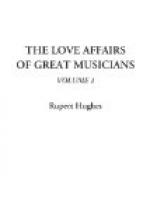Why had Loisa given up all hope of marrying Haydn, even when his wife was dead and she was possessed of his agreement, signed, sealed, and delivered, to marry no one but her? Awhile ago I stooped to repeating the scandal that during Signora Polzelli’s life, Haydn had been casting sheep’s eyes elsewhere. But it is such a pretty scandal! Besides, these old contrapuntists were trained from youth to keep two or more tunes going at once.
I am not referring to Haydn’s friendship with Frau von Genzinger. It was Karajan who discovered and published this pleasant correspondence with her. She was the wife of a very successful physician, a “ladies’ doctor” (Damen Doktor). She was the daughter of the Hofrath von Kayser; her name was Maria Anna Sabina; she was born Nov. 6th, 1750, and had been married some seventeen years, and was the mother of five children when Haydn began taking his every Sunday dinner with the family. Karajan says that she was an ausgezeichnete singer and pianist.
A deep friendship sprang up at once between them and they corresponded freely. Haydn’s letters to her were published by Nohl, and you may read them in Lady Wallace’s translation. They are full of the most interesting lights upon Haydn’s life and experiences, and are brimful of affection for Frau von Genzinger. But the husband and the children are almost always referred to in the letters, and the friendship seems to have been entirely and only a friendship,—as Schmidt calls it, “eine tiefe und zugleich respectvolle Neigung.”
Mr. Upton, who accepts the friendship as “honourable,” finds in Frau von Genzinger the only true feminine inspiration Haydn ever had for composition. “We owe much of his music to his wife; but the savage and truculent manner in which she inspired him was not conducive to the best work of his genius. There is no record that the Polzelli was of any benefit to him musically; certainly she was not morally.”
But there was another woman who idolised Haydn the musician, and with Haydn the man conducted a quaint and curious love duet embalmed in many a billet-doux fragrant with charm.
It was not, then, Frau von Genzinger that threatened Polzelli’s supremacy. Nor was it Madame Bartolozzi, for whom Haydn wrote a sonata and three trios; nor Mrs. John Hunter, who wrote words for many of his canzonets. Nor yet Mrs. Hodges, for whom he composed, and whom he called “the loveliest woman I ever saw.” Nor yet again the fascinating actress, Mrs. Billington, of whom the pleasant story is told, that Haydn, when he went to London, called on Sir Joshua Reynolds at his studio, found him painting Mrs. Billington as “Saint Cecilia listening to the angels,” and protested gallantly that Reynolds ought to have painted the angels listening to her. For which sprightliness he received immediately a fervent hug and a kiss from those so sweet and promiscuous lips. The skeptics object, that Reynolds exhibited the picture in London in 1790, a year before Haydn reached London, but it is a shame to spoil a good and famous story.




